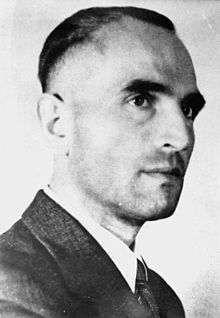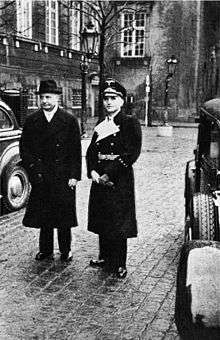Werner Best
| Karl Rudolf Werner Best | |
|---|---|
 Werner Best in 1942 | |
| Born |
10 July 1903 Darmstadt, Hesse |
| Died |
23 June 1989 (aged 85) Mülheim, Germany |
| Allegiance |
|
| Service/ |
|
| Years of service | 1931–1945 |
| Rank | SS-Obergruppenführer |
| Commands held | Amt I, RSHA |
| Battles/wars | World War II |
Karl Rudolf Werner Best (10 July 1903 – 23 June 1989) was a German Nazi, jurist, police chief, SS-Obergruppenführer and Nazi Party leader from Darmstadt, Hesse. He studied law and in 1927 obtained his doctorate degree at Heidelberg. Best served as civilian administrator of France and Denmark while Nazi Germany occupied those countries during World War II.
The Nazi state and World War II
_(2).jpg)
Best joined the NSDAP with member number 341,338. He went on to join the SS with membership number 23,377.[1] He quickly rose to the rank of SS-Brigadeführer and became chief of Department 1 of the Gestapo, which was in charge of organization, administration, and legal affairs.[2] He was a deputy to Reinhard Heydrich. Both men saw the Gestapo as actually working on "behalf of the German people" through both "ethnic and political purification".[3] During 1934, Ernst Röhm pushed for greater political influence for his already powerful Nazi organisation, the Sturmabteilung (SA). Hitler decided that the SA had to be eliminated as an independent political force. On 30 June 1934 the SS and Gestapo acted in coordinated mass arrests that continued for two days.[4] While Heydrich co-ordinated the operation from Berlin, Best was sent to Munich to "oversee a wave of arrests" in the southern part of Germany. The purge became known as the Night of the Long Knives. Up to 200 people, including Röhm, were killed in the action.[5]
Even though Canadian historian Robert Gellately wrote that most Gestapo men were not Nazis, at the same time they were not opposed to the Nazi regime, which they were willing to serve, in whatever task they were called upon to perform.[6] Over time, membership in the Gestapo included ideological training, particularly once Best assumed a leading role for training in April 1936. Employing biological metaphors, Best emphasized a doctrine which encouraged members of the Gestapo to view themselves as 'doctors' to the national body in the struggle against "pathogens" and "diseases"; among the implied sicknesses were "communists, Freemasons, and the churches—and above and behind all these stood the Jews."[7] Heydrich thought along similar lines and advocated both defensive and offensive measures on the part of the Gestapo, so as to prevent any subversion or destruction of the National Socialist body.[8]
Then on 27 September 1939 the SD and SiPo (made up of the Gestapo and the Kripo) were folded into the new Reich Main Security Office (Reichssicherheitshauptamt; RSHA), which was placed under Heydrich's control.[9] Best was made head of Amt I (Department I) of the RSHA: Administration and Legal. That department dealt with the legal and personnel issues/matters of the SS and security police.[10] Heydrich and Heinrich Himmler relied on Best to develop and explain legally the activities against enemies of the state and in relation to the Nazi Jewish policy. In 1939 Best became one of the directors of Heydrich's foundation, the Stiftung Nordhav, and was placed in command of choosing leaders for the Einsatzgruppen task forces and their subgroups (the Einsatzkommandos) from among educated people with military experience; many of them former members of the Freikorps.[11]
Werner Best lost a power struggle within the RSHA and had to leave Berlin in 1940.[12] With the military grade of War Administration Chief (Kriegsverwaltungschef), Best was appointed chief of the Section "Administration" (Abteilung Verwaltung) of the Administration Staff (Verwaltungsstab, Dr Schmid) under then (Militärbefehlshaber in Frankreich or MBF) "Military Commander in France", General Otto von Stülpnagel in occupied France.[12] Best held this position until 1942.[Note 1]
In his efforts as the RSHA emissary in France, Best's unit drew up radical plans for a total reorganization of Western Europe based on racial principles: he sought to unite Netherlands, Flanders and French territory north of the Loire river into the Reich, turn Wallonia and Brittany into German protectorates, merge Northern Ireland with the Irish Free State, create a decentralized British federation and break Spain into independent entities of Galicia, Basque Country and Catalonia.[13]
In November 1942 after the Telegram Crisis, Best was appointed the Third Reich's Plenipotentiary (Reichsbevollmächtigter) in Denmark. He was accredited to King Christian X, who, unlike most Heads of state under Nazi German occupation, remained in power, along with the Danish Parliament, cabinet (a coalition of national unity) and courts.
In this role, Best supervised civilian affairs in occupied Denmark. He kept his position until the end of the war in May 1945, even after the German military commander had assumed direct control over the administration of Denmark on 29 August 1943.
Administration by the Permanent Secretaries

To avoid deportation of Danes to German concentration camps, the permanent secretary of the ministry of foreign affairs, Nils Svenningsen, in January 1944 proposed establishment of an internment camp within Denmark. Best accepted this proposal, but on condition that the camp be built close to the German border.[14] Frøslev Prison Camp was opened in August 1944.
In compliance with the Danish cabinet's decision on 9 April 1940 to accept cooperation with German authorities, the Danish police did cooperate with German occupation forces.[15] This arrangement remained in effect even after the Danish government resigned on 29 August 1943. On 12 May 1944, Best demanded that the Danish police should assume responsibility for protection of 57 enterprises the Germans deemed at risk of sabotage by the Danish resistance movement, which was growing in strength. Should the Danish civil administration not do so, total Danish police strength would be reduced to 3,000 men. Nils Svenningsen, who functioned as "de facto" head of the Danish civil administration in the absence of a Danish government, was inclined to accept this demand, but the organizations of the Danish police opposed it.
The rejection of the German request was delivered to Best on 6 June 1944. This reduced the Gestapo's already limited trust in Danish police even further. On 19 September 1944 the German army began arresting members of the Danish police forces; 1,960 policemen were arrested and deported to German concentration and prisoner-of-war camps.
In deliberations on 3 May 1945 about preparation for the impending German defeat, Best fought to avoid implementation of a scorched earth policy in Denmark.[16]
After the war
After the war, Best testified as a witness at the Nuremberg Trial of the Major War Criminals and was later extradited to Denmark. In 1948, Best was sentenced to death by a Danish court, but his sentence was reduced to five years in prison (of which he had already served four years). This created outrage among the Danish public, and the Supreme Court changed the sentence to 12 years. Best was released in 1951. In 1958 Best was fined by a Berlin de-Nazification court for his actions during the war. In 1972 he was charged again when further war crimes allegations arose. He was found medically unfit to stand trial and was released.
After that, Best was part of a network that helped former Nazis and spent his time "campaigning for a general amnesty".[17] He died in Mülheim, North Rhine-Westphalia, in 1989.
See also
Notes
- ↑ This function was less important than the one Best had had in the RSHA. The Military Command in France had two Staffs: Administration and Command (Kommandostab); the Administration Staff had four Sections: "Central"; "Administration"; "Economy"; "War Economy". Ref.: La France pendant la Seconde Guerre mondiale. Atlas historique, Éditions Fayard (2010).
References
Citations
- ↑ Biondi 2000, p. 13.
- ↑ McNab 2009, p. 156.
- ↑ Evans 2005, p. 116.
- ↑ Kershaw 2008, pp. 309–314.
- ↑ Gerwarth 2011, pp. 79–80.
- ↑ Gellately 1992, p. 59.
- ↑ Dams & Stolle 2014, p. 30.
- ↑ Dams & Stolle 2014, p. 31.
- ↑ Longerich 2012, pp. 469, 470.
- ↑ Höhne 2001, p. 256.
- ↑ Evans 2008, p. 17.
- 1 2 Gerwarth 2011, p. 165.
- ↑ Langbehn & Salama 2011, p. 61.
- ↑ Kirchhoff, Lauridsen & Trommer 2002, p. 178–179.
- ↑ Kirchhoff, Lauridsen & Trommer 2002, p. 367.
- ↑ Kirchhoff, Lauridsen & Trommer 2002, p. 41.
- ↑ Evans 2008, p. 749.
Bibliography
- Biondi, Robert, ed. (2000) [1942]. SS Officers List: (as of 30 January 1942): SS-Standartenfuhrer to SS-Oberstgruppenfuhrer: Assignments and Decorations of the Senior SS Officer Corps. Atglen, PA: Schiffer. ISBN 978-0-7643-1061-4.
- Dams, Carsten; Stolle, Michael (2014). The Gestapo: Power and Terror in the Third Reich. Oxford and New York: Oxford University Press. ISBN 978-0-19966-921-9.
- Evans, Richard J. (2005). The Third Reich in Power. New York: Penguin Group. ISBN 978-0-14-303790-3.
- Evans, Richard J. (2008). The Third Reich at War. New York: Penguin Group. ISBN 978-0-14-311671-4.
- Gellately, Robert (1992). The Gestapo and German Society: Enforcing Racial Policy, 1933–1945. New York: Oxford University Press. ISBN 978-0-19820-297-4.
- Gerwarth, Robert (2011). Hitler's Hangman: The Life of Heydrich. New Haven, CT: Yale University Press. ISBN 978-0-300-11575-8.
- Höhne, Heinz (2001) [1969]. The Order of the Death's Head: The Story of Hitler’s SS. Penguin. ISBN 978-0-14139-012-3.
- Kershaw, Ian (2008). Hitler: A Biography. New York, NY: W. W. Norton & Company. ISBN 978-0-393-06757-6.
- Kirchhoff, Hans; Lauridsen, John T.; Trommer, Aage, eds. (2002). Gads leksikon om dansk besættelsestid, 1940–1945 [Gads Encyclopedia of Danish Occupation, 1940–1945] (in Danish). Copenhagen: Gads Forlags.
- Langbehn, Volker; Salama, Mohammad (2011). German Colonialism: Race, the Holocaust, and Postwar Germany. New York: Columbia University Press. ISBN 978-0-23114-973-0.
- Longerich, Peter (2012). Heinrich Himmler: A Life. Oxford; New York: Oxford University Press. ISBN 978-0-19-959232-6.
- McNab, Chris (2009). The SS: 1923–1945. London: Amber Books. ISBN 978-1-906626-49-5.
External links
| Wikimedia Commons has media related to Werner Best. |
- WorldStatesmen - Denmark
- Westermann Verlag, Großer Atlass zur Weltgeschichte (in German)